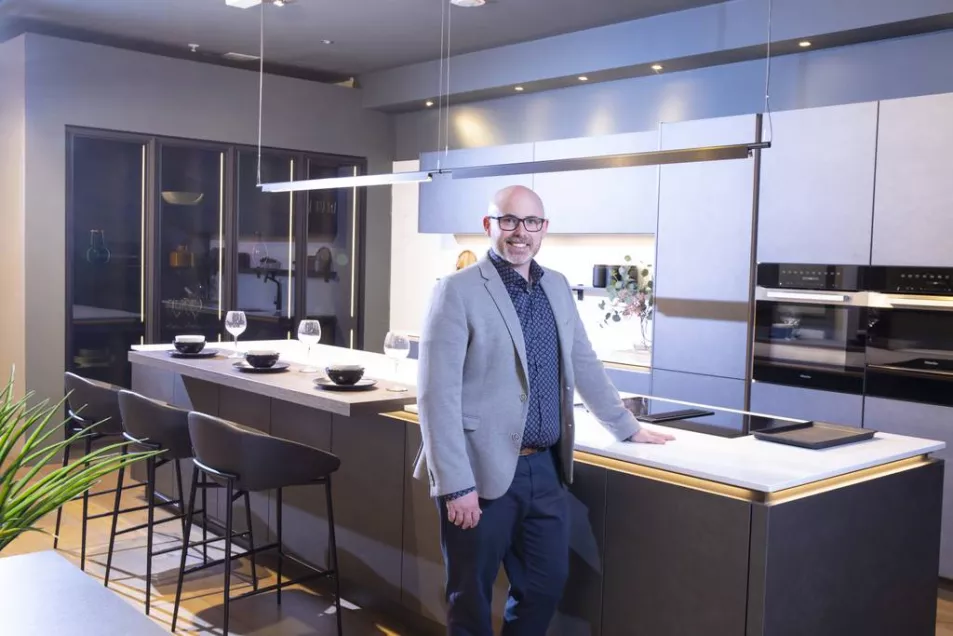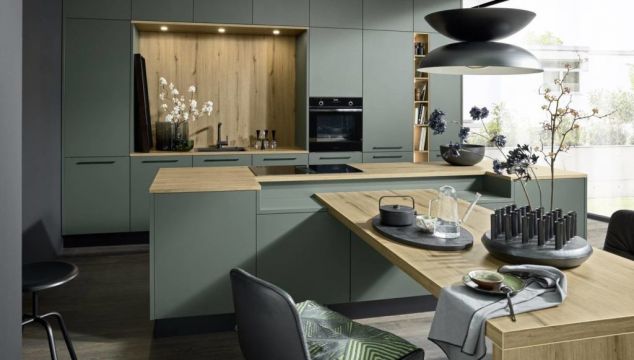1. What is the first thing you need to consider when buying a kitchen?
Ideally, your new kitchen wishlist would be the best starting point. The wishlist is you considering what you want to achieve from your new kitchen and how it can work best for you and your household. For example, do you need more storage than you have currently or is a brighter space important to you. Could your worktop area be bigger and work harder for you. Should your kitchen be a more social space where family and friends can gather. And are there any new appliances or technology to make your life easier.
And then, of course, what is my budget and how can I get the most from it. Your kitchen designer needs a good idea of your budget to ensure you are getting the best value in terms of where to allocate and prioritise the spend.
2. How do I start planning my kitchen design/layout and product choices?
It can be quite daunting when you start to choose a kitchen, therefore at Kube we break it down into five main elements:
· the number of kitchen units required (room size)
· door type/style
· type of worktop i.e stone, laminate or wood
· storage inserts & accessories e.g drawers, cutlery organisers, track lighting
· appliances
The design, or layout, is your starting point. There is no one single layout that is optimal, each kitchen is different and should be designed to suit the space. There are definite rules to follow for good kitchen design such as distances in walkways, heights of work surfaces and prep areas and positioning of appliances.
Pantry and fridge locations should suit the prep area in the kitchen. An eye level dishwasher can reduce the work of loading and unloading. Once these main design decisions are complete then you can move onto the next element, the style of the kitchen including colour, materials and textures.

3. What type of worktop options are there?
There are a three main choices available in the market:
1) Quartz is the most popular choice worldwide due to its robustness for everyday use while also being a good value option. The consistency of colour throughout the slabs, when compared to natural stone, means the colour you pick on the sample or in the showroom is exactly what you will get in your home. It also has stainproof properties making it suitable for use in a kitchen environment. Silestone is one brand of quartz popular in Ireland, they have a large range of colours and good customer service.
2) Dekton, which is relatively new to the market, is a ceramic worktop which is incredibly hard wearing and durable. It’s completely heat-resistant; you can chop vegetables, prepare your meals and not worry about scratches or marks appearing on the worktop. In addition it comes in an array of different colours and shades.
3) Natural marble is a beautiful finish for your worktop and can add real drama and personality to your kitchen. It is a softer material and does require a good deal of care and maintenance. Natural granite and marble, both beautiful materials, are generally more expensive than a quartz option.
4. What inserts/accessories should we consider?
Cutlery and utensils inserts are the obvious and most essential accessories to consider. An integrated bin system with separate compartments and a lid allows easy separation of general waste, recyclables and food waste. Proper planning of shelves to suit your individual storage needs, with the addition of internal drawers to use all the internal space of normal drawers, makes for a tidy and well-organised kitchen. Why not try some of the trendy additions available such as foil cutters, knife holders and spice drawers for that extra bit of luxury.
5. What are the important requirements from appliances?
Your appliances should suit your needs and work hard for you and your household.
If you are an avid cook, your ovens will be important to you. Each oven on the market today has a different function beyond the basic roasting or grilling that you will be expecting. Discuss with your designer what is important to you. A steam function for your vegetables and rice may be of interest, or you may prefer a larger microwave. Bakers may like a dough proving function and lower temperatures while a teppanyaki hob might suit the more adventurous. And, of course, a bean to cup coffee machine is a must for the coffee lovers out there.
Extraction of cooking odours and steam has made huge advancements in recent years. Do ask your kitchen designer about downdraft extraction combined with your hob for the most up-to-date functionality.
Consider the size of your fridge and freezer carefully, it is one of the main storage spaces in the kitchen.
Finally, the energy efficiency of your appliance means that the higher rated ones will generally be a bit more expensive but will be worth it in the longer run as you save money on your electricity over their lifespan.
6. What should we bear in mind when choosing the quality of products for our kitchen?
Trends come and go, but what is important is that your kitchen should last for 15 to 20 years. Extensive market research tells us that choosing quality finishes and products that will stand the test of time is very important to our customers at Kube.
You may decide to choose less expensive appliances and upgrade them in a few years when the budget allows, but investing in a quality kitchen gives you the foundation on which to build. It is also worth noting that a good quality kitchen will enhance the value of your property, which may be important if you are planning to move in the medium term.
7. How long does it take from visiting the showroom to installation of a kitchen?
The project has three stages: design, order and installation. The design phase on average takes four to six weeks which allows time to consider all the important aspects of the design and to finalise colours and finishes. Some people like to move at a slower pace and this stage of the process is within the homeowners control.
After placing your kitchen order, you should allow at least eight weeks to installation and completion.
8. What should we budget for our new kitchen?
Every customer is unique. The size of the room, the style and the appliances will all have an impact on your budget and spend. However, you have complete control over your spend and how you would like to allocate it. At Kube, we have a handy guide to help you decide on that kitchen budget. Your designer will walk you through each area, and you can bring the calculator home with you to complete in the comfort of your own home. On average, a new kitchen budget would be €15,000 to €20,000.
For advice on designing a new kitchen for your home visit one of the six Kube showrooms in Dublin, Cork or Galway or log onto www.kubeinteriors.com to book a consultation.








